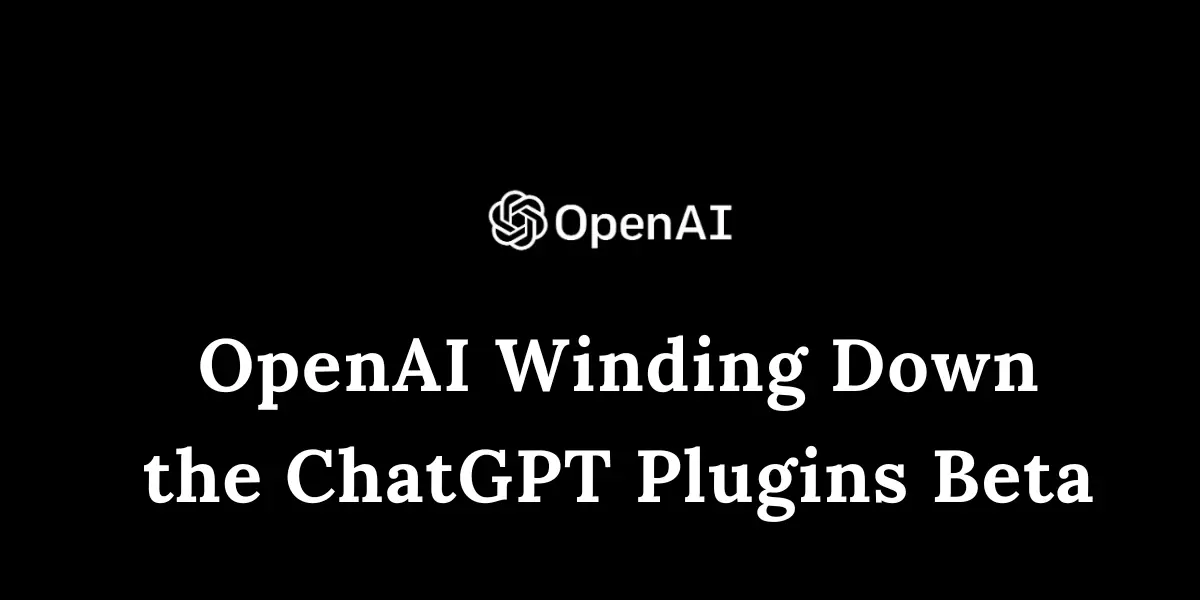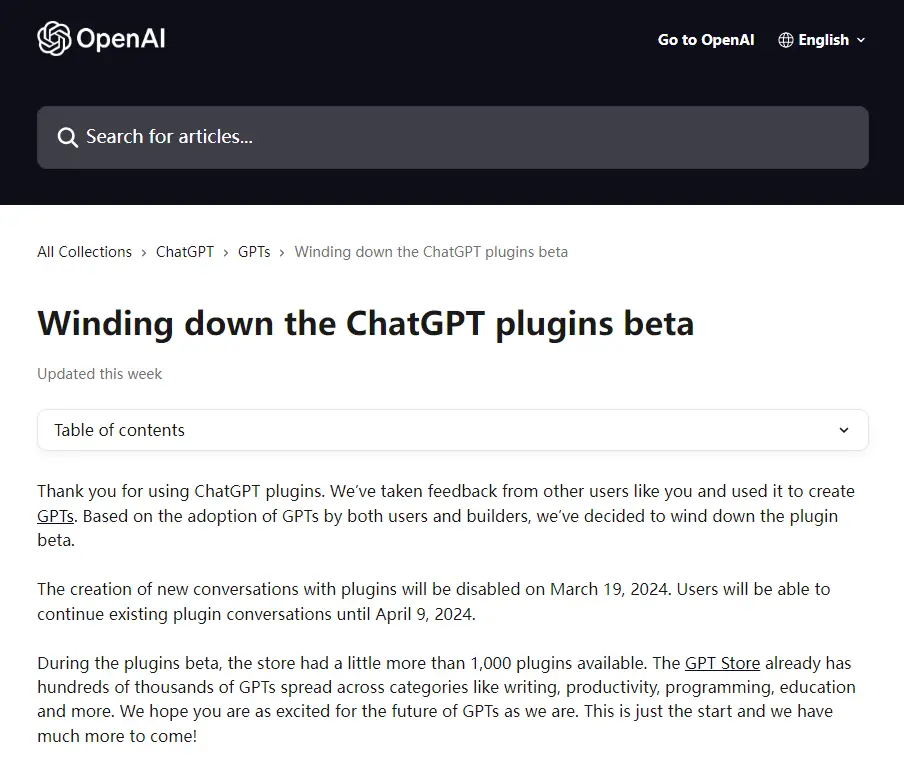OpenAI Winding Down the ChatGPT Plugins Beta

In a surprising turn of events, OpenAI has announced its decision to wind down the ChatGPT Plugins Beta, a move that has sparked discussions and speculations within the tech community. This decision marks a significant shift in OpenAI’s strategy, reflecting its ongoing evolution and adaptation in the rapidly advancing field of artificial intelligence.
OpenAI is winding down the ChatGPT Plugins Beta, transitioning focus to the broader potential of GPTs. This strategic shift highlights OpenAI’s commitment to advancing core AI technologies and shaping the future of human-AI interaction.
Table of Contents
What is ChatGPT Plugins?
ChatGPT Plugins were introduced as an innovative extension to the ChatGPT framework, designed to enhance its capabilities by integrating external data sources and services directly into the chat interface. This allowed for a more dynamic and versatile interaction, where users could execute a variety of tasks and access a wealth of information without leaving the chat environment.

What is GPTs?
GPTs, or Generative Pre-trained Transformers, are a class of AI models developed by OpenAI, designed to understand and generate human-like text based on the input they receive. These models have been at the forefront of AI research and application, powering a wide range of tools and services, including the widely popular ChatGPT
Key Features of GPTs
Advanced Natural Language Understanding
- Deep learning algorithms
- Contextual comprehension
GPTs stand out for their advanced natural language understanding capabilities, enabling them to grasp the nuances of human communication and respond in a coherent and contextually appropriate manner.
Generative Text Capabilities
- High-quality content generation
- Creative and informative responses
The generative text capabilities of GPTs allow them to produce content that is not only informative but also creative, making them versatile tools for a variety of applications, from writing assistance to customer service.
Continuous Learning and Adaptation
- Feedback loops
- Model fine-tuning
GPTs are designed to continuously learn and adapt, improving their responses over time through feedback loops and model fine-tuning, ensuring their relevance and effectiveness in a changing world.
How to Use GPTs?
Step 1: Choose the Right Model
Selecting the appropriate GPT model is crucial, as different models are optimized for various tasks and levels of complexity.
Step 2: Define Your Input
Clearly define the input or prompt you want to provide to the GPT, ensuring it is concise and to the point to elicit the desired response.
Step 3: Customize the Parameters
Adjust the parameters of the GPT model, such as temperature and max tokens, to fine-tune the output according to your requirements.
Step 4: Interpret the Output
Carefully interpret the output generated by the GPT, considering its context and the potential need for further refinement.
Step 5: Iterate and Improve
Use the output as a basis for further iterations, refining your input and parameters as needed to achieve the best results.
GPTs VS ChatGPT Plugins
The landscape of artificial intelligence is ever-evolving, with Generative Pre-trained Transformers (GPTs) and ChatGPT Plugins standing out as two significant innovations. While both have their roots in enhancing AI interactions, they serve distinct purposes and offer unique advantages.
Integration Capabilities
GPTs are foundational AI models designed to understand and generate human-like text, serving as the backbone for various AI applications. Their strength lies in generating coherent and contextually relevant responses based on the input they receive. In contrast, ChatGPT Plugins extend the functionality of these models by allowing direct integration with external services and APIs, thereby enabling ChatGPT to perform tasks beyond text generation, such as booking appointments or fetching real-time data.
Scope of Application
GPTs are versatile in their application, capable of content creation, conversation, and even coding assistance. ChatGPT Plugins, however, were specifically designed to enhance ChatGPT’s utility by bridging the gap between AI-generated content and actionable tasks. This added a layer of practicality to ChatGPT, making it not just a conversational agent but a tool capable of executing specific functions within its dialogue flow.
User Experience
From a user experience perspective, GPTs offer a seamless interaction that’s limited to the exchange of text-based information. ChatGPT Plugins, however, expanded this experience by integrating real-world functionalities into the chat interface, making AI interactions more dynamic and utility-driven. This integration brought AI closer to everyday tasks, enhancing user engagement and the practical value of ChatGPT conversations.
When will the plugin store stop being accessible?
The closure of the ChatGPT Plugins store marks a significant transition in OpenAI’s strategy, with the platform set to become inaccessible on March 19, 2024. This decision signifies the end of an era for ChatGPT’s extended functionalities through third-party integrations. Users will face a pivotal change as they will no longer be able to install new plugins or initiate new conversations using existing plugins beyond this date. This move not only impacts the availability of diverse plugins that added depth to ChatGPT’s interactions but also heralds a shift towards a new direction in the development and application of GPT models.
Why winding down the plugin beta?
The decision to wind down the ChatGPT Plugins Beta is a strategic move by OpenAI, driven by the broader adoption and development of GPTs. This pivot reflects a focus on harnessing the core capabilities of GPT models and integrating feedback from the beta phase to enhance and streamline AI interactions. The winding down process is indicative of OpenAI’s commitment to innovation and its continuous effort to refine and advance its AI technologies. By concentrating on the development of GPTs, OpenAI aims to unlock new potentials and applications in AI, ensuring that the technology remains at the forefront of AI research and application. This transition underscores OpenAI’s dedication to creating more robust, versatile, and directly integrated AI solutions that continue to push the boundaries of what AI can achieve.
Final Words
OpenAI’s decision to wind down the ChatGPT Plugins Beta is a pivotal moment that underscores the dynamic nature of the AI landscape. As the community bids farewell to ChatGPT Plugins, the focus shifts to the future of GPTs and their potential to redefine our interaction with AI. This transition opens up new avenues for innovation and application, promising an exciting future for AI enthusiasts and users alike.

